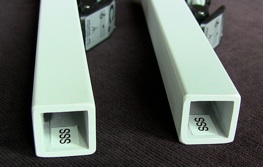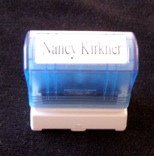It’s a good idea to mark bells both visibly (so you know which are yours at a handbell conference) and invisibly (so you can prove stolen bells belong to you if the police recover them, or if they show up on eBay). I’ll talk about how to do both, as well as marking other equipment. Marking all your equipment is a critical part of preparing for your first handbell event, or a concert with other handbell musicians.
At the first handbell conference where I solo rang, I watched with astonishment as someone from the bell choir behind me reached under my solo table and helped herself to my nylon foam bag. When I mentioned the bag belonged to me, the ringer said, “It looks just like ours.” Well, it would, wouldn’t it? When you see bell choirs at conferences with their equipment conspicuously marked, that’s why.
 To mark my bells, I made initial labels with a label-maker, as shown in this photo.
To mark my bells, I made initial labels with a label-maker, as shown in this photo.
Since I have two sets of bells, I used different colors of label-maker tape for each set, so I can tell them apart. Put the labels where they won’t catch on your gloves or distract you as you ring. I put them inside the handles, just on the other side of the bell symbol. I’ve also seen bright pony-tail holders used around the handle near the handguard. Then you can see what’s yours from across the room.
If you buy secondhand bells with gummy labels inside from the previous owner, use a little rubbing alcohol on a rag to remove it.
If you buy Malmark bells, you can have text put inside the handles that will identify either you or your church.
 You can place a label inside the hollow part of chimes. These chimes have the church’s initials.
You can place a label inside the hollow part of chimes. These chimes have the church’s initials.
While you have the label-maker handy, make extra labels to mark music stands, bell tree stands, binders, carts, plastic storage boxes, etc. Make some labels with your name, some with your name and phone number, and some with your initials.
Here are initial labels attached to mallets on the shaft just above the handle:  

 To mark bells invisibly, take each bell apart, which is easiest when you disassemble the bells anyway for polishing. You can mark the tang protruding from the shoulder of the casting, using nail polish or, if you have very steady hands, an etching tool. This will be hidden when the bell is reassembled. The picture at right shows the tang; the small pin sticking out is the index pin, used to line up all the parts of the bell. If the bells are ever stolen, you can tell the police “we can take one bell apart, and my bells have 3 fluorescent pink dots (or an etched triangle, or whatever).” Though Schulmerich told me that marking the tang wouldn’t affect the acoustics of the bell, and they themselves etch the pitch of each casting there, please double-check before you fire up that etching pen.
To mark bells invisibly, take each bell apart, which is easiest when you disassemble the bells anyway for polishing. You can mark the tang protruding from the shoulder of the casting, using nail polish or, if you have very steady hands, an etching tool. This will be hidden when the bell is reassembled. The picture at right shows the tang; the small pin sticking out is the index pin, used to line up all the parts of the bell. If the bells are ever stolen, you can tell the police “we can take one bell apart, and my bells have 3 fluorescent pink dots (or an etched triangle, or whatever).” Though Schulmerich told me that marking the tang wouldn’t affect the acoustics of the bell, and they themselves etch the pitch of each casting there, please double-check before you fire up that etching pen.
You can mark bell cases using stencils, which are also useful for noting the bell range inside each case. Or put distinctive luggage tags or yarn pompons on the bell case handles.
Use a fabric marking pen to mark your mallet bag.
Use a felt-tip marker to write your name on the edge of your foam pads (if uncovered), or on the muslin covers, if you have them. If your table covers are attached to the pads, you can mark your name on the underside, which is usually muslin or similar fabric. You can use the same marker to write your name on the underside of your tables. I go one step further and mark the order for lining up the tables and foam pads, to help ensure a level surface.
You can also use a felt-tip marker to write your initials on the wristband of your gloves. Or you can buy small beads with your initials and sew them on.
 Marking sheet music is a two-step process. First, order a self-inking stamp from an office supply store to mark the sheet music itself. Then create a binder for your accompanist. Use one with a clear cover into which you insert a page with your name, phone number, and a handbell graphic. This helps your music get returned, not mixed in with other sheet music. While you’re making one binder, make 2 or 3, in case you work with multiple accompanists. For my regular accompanist, I create a separate binder of Christmas music, with a Christmas sticker on the cover page. That way, she can see immediately which binder is which.
Marking sheet music is a two-step process. First, order a self-inking stamp from an office supply store to mark the sheet music itself. Then create a binder for your accompanist. Use one with a clear cover into which you insert a page with your name, phone number, and a handbell graphic. This helps your music get returned, not mixed in with other sheet music. While you’re making one binder, make 2 or 3, in case you work with multiple accompanists. For my regular accompanist, I create a separate binder of Christmas music, with a Christmas sticker on the cover page. That way, she can see immediately which binder is which.
If you have business cards, put one in the plastic box holding your table covers, in your garment bag (there’s often a plastic sleeve for this), and on your foam bag (ditto). And keep an eye out for that careless ringer at your next handbell event.
Copyright © 2012 Nancy Kirkner, handbells.com